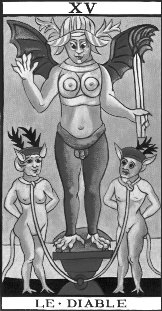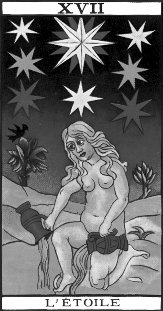

In the previous section, we saw how God created the world by filling ten vessels with light, but how some vessels shattered because they were unable to hold all of this light. The only way the vessels would be able to accept light would be if they were to give light as well as receive it.
This raises an important question: What's the point? Presumably, God could have created proper functioning vessels the first time around. So why did God go through the trouble of creating and trying to work with vessels that were so obviously defective? (Note again: This is not a discussion of physics, but an archetypal idea. Note, too, that some of these ideas are presented in the literature of qabala, in works by Aryeh Kaplan, for instance. But much of this section contains my own ideas on how to see an important qabalistic archetype at work in ways that may not seem obvious.)
The answer is that the presence of a "defect" was an important part of God's plan right from the outset. The creation of vessels that shattered is tantamount to the creation of an evil; more importantly, an evil that can be rectified. (Rather than considering the word "evil" in mundane terms, think of it as representing the opposite of divine perfection, as not Godlike, etc.) But we don't know for sure that it will be rectified. We only know that rectification is possible. Humans can choose to repair the situation, or they can simply accept the defective state of the world and leave it at that. Free will. That's the point here.
Although the breaking-of-the-vessels metaphor is specific to Jewish qabala, the overall archetype, the idea that the world is imperfect and that we somehow or other can achieve a state of perfection, is much broader and arguably exists in every spiritual system. The metaphors change, but the archetype is present. Jewish qabalists tell us that we achieve rectification by performing the "mitzvot" (approximate translation: obeying God's commandments) spelled out in the Torah. Christians could view acceptance of Christ as the path to rectification.
Eastern systems are arguably much more direct and less metaphoric in addressing the issues that underlay the breaking of the vessels. We saw in the previous section that the cataclysm was caused by inherent deficiencies of the vessels when in the state of Nekudim (spotted), wherein each tried to be completely self contained. Eastern teachings constantly remind us that we are not truly independent beings but that we are, in fact, all connected to the same Godhead (Brahmin, as it's referred to by Hindus, for example). Anything we do to honor the interconnectedness among all beings is a step toward rectification. We also saw how the vessels tried to take light, but never give. They were the penultimate accumulators. But is this practical? Consider what the Tao The Ching (ch. 9) has to say about this topic:
To hold and fill a vessel to brimful
Is not so good as to stop before the limit.
Hone a tool to its sharpest state,
And its keenness cannot be long preserved.
A hall filled with jade
Can hardly be safeguarded.
To show pride in one's wealth and high rank
Is to pave the way for one's own doom.
Retire after achieving success and winning renown!
This is the way of heaven.
As explained by Henry Wei (The Guiding Light of Lao Tzu Quest Books ISBN 0-8356-0558-2), this passage "warns against going to the limit and, what is worse, going to excess, in one's endeavors. It counsels people to eschew pride and vanity and practice contentment and moderation or the Golden Mean."
Obviously, Taoism and Qabala are two different systems each with its own structure and it's probably too much to expect clean, simple correspondences among each one's respective individual components. So I'm not saying that this passage corresponds in a smooth one-to-one with a specific doctrine of qabala. But from the quoted passage, doesn't it seem reasonable to assume that Lao Tzu would have been readily amenable to the idea that divine vessels which only take light and never give any would eventually be unable to withstand the extreme pressure and would eventually shatter? I believe he'd have been quite comfortable with the archetype, even though he expressed the underlying ideas through a different set of metaphors.
Besides establishing a choice to rectify or not rectify, there's another reason why God took the trouble to create defective vessels that would shatter as opposed to starting out with vessels that could give and receive in harmony with others. We have the idea of the shattering as an "evil." But we also have an evil that has its roots in goodness, in divine perfection. The evil is made up of all the pieces of the broken vessels that fell to earth. These fragments, despite being separate and scattered, still have their roots in God's creation.
This spotlights the idea that when we raise ourselves spiritually (based on whatever tradition we follow), we aren't journeying to a new place. We aren't becoming something we've never been. Instead, we're really returning to a place from which we've come. We're going back to our source. Some traditions see a vast gulf between humanity and divinity. Others see humanity and divinity as one and the same, with humanity merely being an aspect of divinity. In the latter view, the challenge is for people to grow beyond the illusion, or "maya," that causes us to believe we are separate from the divine (through a series of lifetimes, in the case of traditions that work with the idea of reincarnation, as does qabala, in its way). By likening spiritual evolution to the process of restoring and rectifying the broken vessels, or put another way, by rectifying the evil that has its ultimate source in divine goodness, it can be argued that qabala belongs among those traditions that stress the connectedness of humanity and divinity.
 THE DEVIL |
 THE STAR |
God could have created vessels that were connected and which had the ability to give and receive, and could have simply left us with a choice to use or not use the full range of capabilities of these functional vessels. But that's not what happened. Why the breaking? Why the cataclysm? And this idea of cataclysm is one that recurs throughout the Bible: the expulsion form Eden, the flood, the golden calf incident (when Moses broke the first set of stone tablets), and beyond the Torah, we see it in the destruction of the Jerusalem temples. The theme of cataclysm and rectification is a recurring one. The tarot deck picks up on this theme.
 THE TOWER |
 THE MOON Images of H. Fournier's Tarot de Marseilles taken from Lucian Wischik's Tarot cards page |
Why can't things simply go smoothly the first time? Anyone who has tried to get a child to earn some pocket money by baby sitting, yard work, etc. may already recognize something. We tell the child how much more he/she will appreciate that which is received if it's earned, achieved through effort, and not simply handed over.
One aspect of the new age involves channeled entities and teachers, with the Seth entity, channeled by the late Jane Roberts, being a particularly noteworthy one. An important aspect of the Seth teaching is the idea that "you create your own reality." Many who hear this reject the idea, or even see it as laughable. If I create my own reality, they say, why on earth would I have created all these horrible things that are happening in my life? I'd never create anything like that. Those arguing against the existence of any sort of God often use an analogous line of reasoning. If God exists, how could he create or allow all these horrible things?
But these questions assume that humans exist for no reason other than to sit around being happy and content (whatever that means). The qabala, along with other traditions, teach us that we are here to evolve, to develop, to grow, or in line with the vessels archetype, to restore evil to its divine roots. Our experience of divinity is enhanced by the process we go through to build it, to develop it, to earn it, etc. Cataclysm propels us forward; it gives us a reason to not want to stay where we are. And we can, indeed, go forward. It's not always apparent how this is happening, or even if it's happening at all. Sometimes, it appears that no good at all can possibly be extracted from a situation. But there are perspectives that we cannot perceive with human logic, and systems that work with reincarnation do not promise that rectification can be achieved within the space of an individual lifetime. Even so, the breaking of the vessels reminds us that the process is present, whether or not we can see logically exactly how it works within the context of a particular lifetime.
The solution to the cataclysm of the breaking of the vessels is directly contained in the event itself. Why did the vessels break? Because they were unable to give light and work together as a unit. What's the solution? Create vessels that can give light and work together. This seems obvious. But in life, we sometimes overlook the fact that the solutions to crises are contained within the crises themselves. Cataclysms typically occur because of some sort of imbalance, or extreme situation. In the case of the vessels, the imbalance was in the fact that they only received light and couldn't give.
But even in more mundane areas of life, the key to rectifying a cataclysm is to identify the excess that caused it and to strive for a sense of balance. For instance, the 1929 stock market crash and resulting depression was caused by imbalances in the financial system; the inability of money to flow to where it was needed due to the gold standard, trade barriers, etc. (sort of like the light that couldn't originally move from one vessel to the next) and unrestrained speculation by financial companies (margin debt, speculation by banks, etc.). The solutions: create a more balanced flow of funds as well as a more balanced regulatory environment for financial institutions. The result: a financial system that functioned smoothly for more than 60 years and withstood a 1987 stock market crash with barely a shrug. The stock market and qabala seem light years apart, but in fact, the lessons of the breaking of the vessels apply quite well. It likewise applies in economics, another discipline that may seem far afield. When looking to forecast recessions, economists are always on the lookout for imbalances.
![]()
| This page is hosted by |
| Get your own Free Homepage |